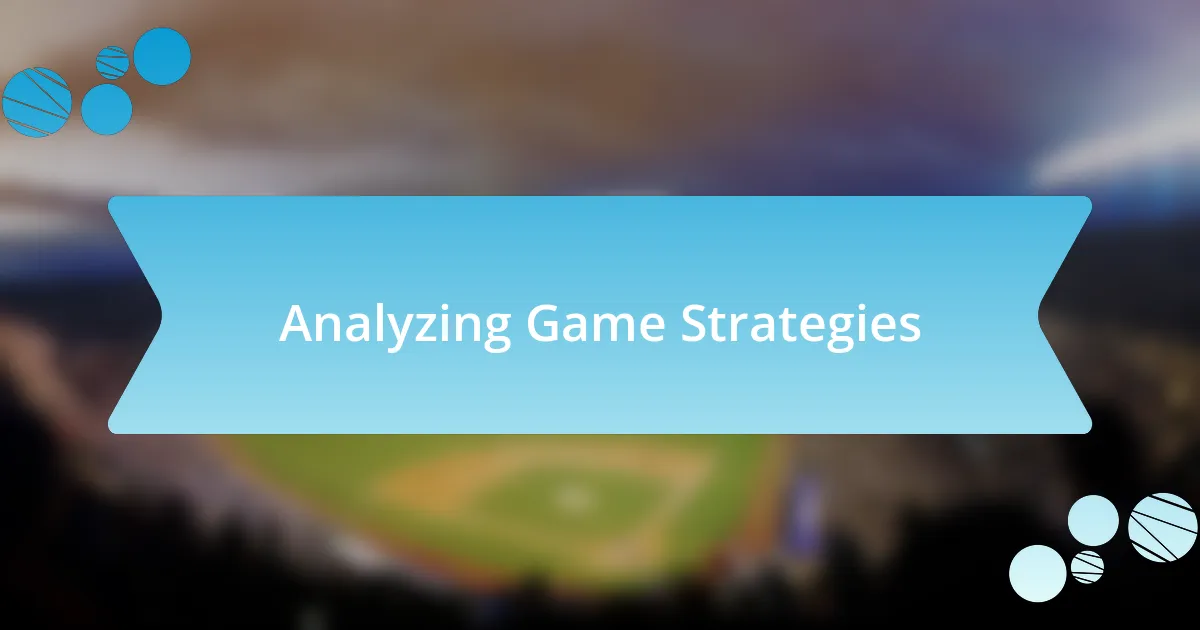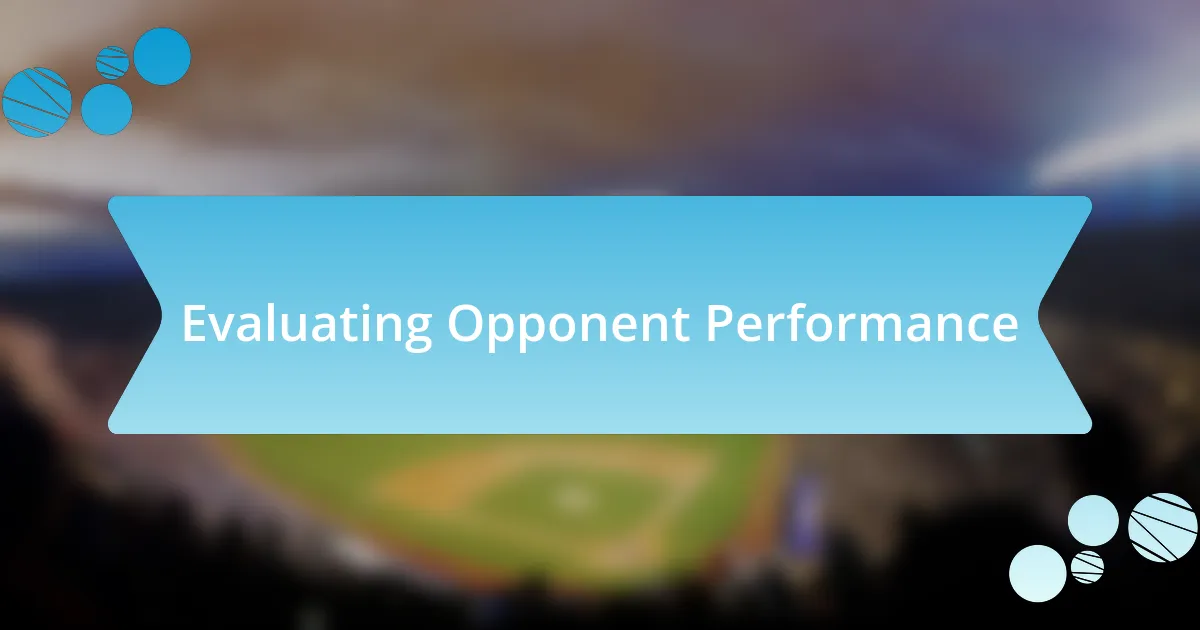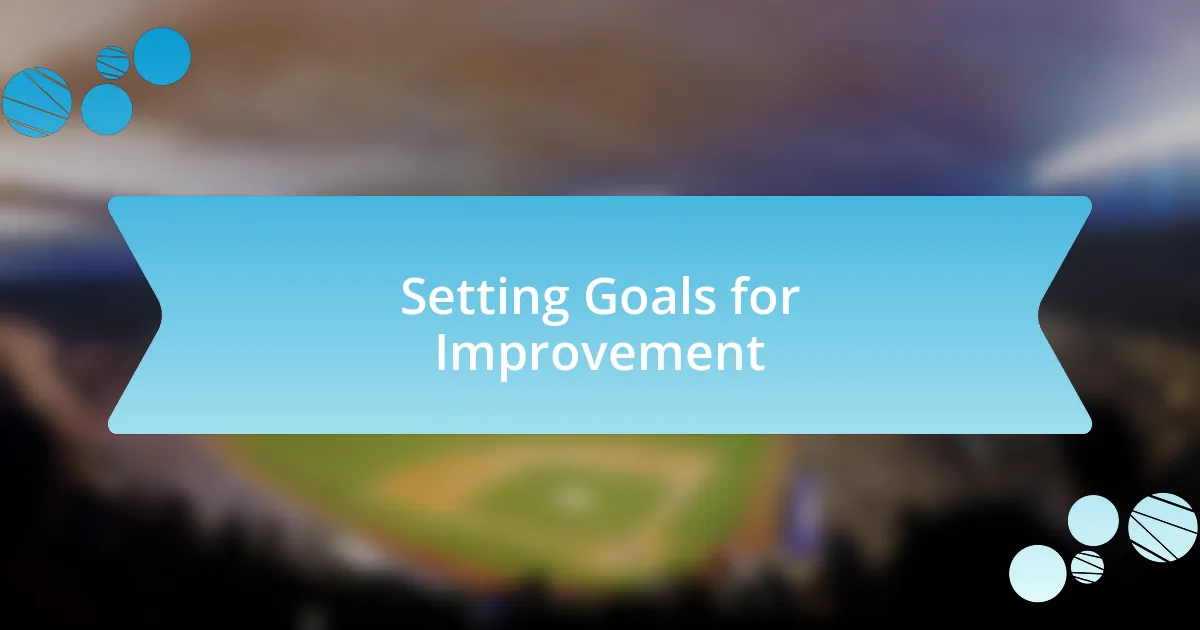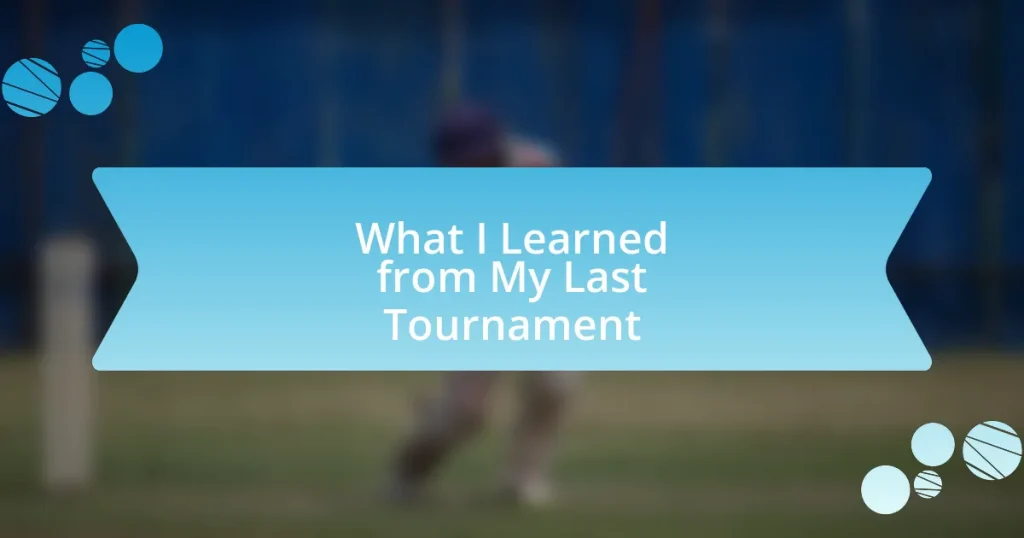Key takeaways:
- Collecting and analyzing tournament data reveals patterns in performance and emotional responses, leading to improved self-reflection and strategy adjustments.
- Identifying relevant metrics, such as win-loss ratios and critical decisions, helps focus on areas that drive personal growth and effective training regimens.
- Understanding both personal and opponent performance, including emotional influences and strategic tendencies, enhances competitive strategies and adaptability during matches.
- Setting specific, achievable goals based on weaknesses—like improving return skills—can significantly impact overall performance through consistent practice and motivation.

Gathering Tournament Data
Collecting data from my tournament experiences was an eye-opening process. I realized that keeping track of not only my scores but also my strategy choices often revealed patterns I hadn’t noticed in the heat of competition. Have you ever looked back at your game footage and spotted a critical mistake that you missed during play?
In one tournament, I meticulously recorded each match’s details: my moves, my opponents’ strategies, and even the times when I felt particularly stressed. This approach brought clarity and reinforced the importance of self-reflection. I found it fascinating how identifying my emotional responses during intense moments helped illuminate my gameplay weaknesses.
I often utilized various tools to compile my tournament data, from detailed spreadsheets to gaming apps. Each method provided unique insights into my performance, but it was the raw data that often told the most impactful story. What have you found most effective when gathering your performance data? It’s a process that can transform how we learn and grow in our competitive journeys.

Choosing Relevant Metrics
Choosing the right metrics is essential for a meaningful analysis of my tournament performance. I always start by focusing on metrics that directly align with my gameplay goals. For instance, tracking the number of critical decisions I made per match alongside my win-loss ratio revealed a strong correlation; when I made more thoughtful choices, my outcomes improved significantly. Have you ever noticed how certain metrics resonate more with your playing style than others?
In my experience, I’ve learned not to get lost in the sheer volume of data. Initially, I tried logging every detail, from time spent strategizing to the number of times I executed specific moves. However, I quickly realized that relevant metrics like win percentages and decision-making efficiency provided clearer insights. Simplifying my approach allowed me to hone in on what truly mattered, which ultimately drove my personal growth in competitions.
Lastly, I found it helpful to compare my metrics with those of my peers. This comparative analysis provided a broader perspective on my performance. For example, while my average game time was slightly longer, it often led to more strategic victories. Finding this balance between metrics allowed me to visualize my strengths and areas for improvement more effectively. Participation in discussions about metrics with fellow competitors has also enhanced my understanding. What metrics do you focus on, and how do they shape your training regimen?
| Metric | Description |
|---|---|
| Win-Loss Ratio | A simple measure of how often I win compared to the total number of matches played. |
| Critical Decision Count | The number of significant decisions made during matches and their influence on the match outcome. |
| Game Time | The average duration of matches, helping gauge pace and efficiency. |
| Opponent Strategies | A record of the opposing strategies faced to identify effective countermeasures. |

Analyzing Game Strategies
Analyzing game strategies is where I often find the most significant insights into my performance. Each match serves as a unique puzzle, requiring me to adapt my approach based on my opponent’s movements and tactics. I recall a specific tournament where I faced a player known for their aggressive playstyle. Initially, I struggled to counter their strategies. However, after reviewing my gameplay, I realized that my earlier success came from maintaining distance and exploiting openings. The moment I shifted my strategy to be more evasive, my odds improved. This taught me that continuous reflection on game strategies can lead to a profound evolution in my approach.
To facilitate my analysis, I focus on the following strategies that have proven effective in my tournaments:
– Adaptability: Adjusting my tactics based on the opponent’s strengths and weaknesses.
– Patterns and Trends: Identifying recurring maneuvers within my gameplay and those of others.
– Counter Strategies: Developing specific responses to the prevalent strategies I encounter.
– Post-Match Reviews: An in-depth examination of how individual moves could have been optimized.
– Mental Notes: Keeping track of emotional reactions during play to understand the psychological impact on performance.
By dissecting these facets, I can refine my strategies more effectively than just relying on metrics alone, creating a strategy toolbox that I can draw from in future matches. The interplay of emotion and analysis, especially after a loss, often fuels my determination to improve. Have you ever felt inspired to change your approach after a close match?

Evaluating Opponent Performance
When evaluating opponent performance, I often focus on specific tendencies that repeatedly surface throughout matches. During a recent tournament, I noticed that one opponent consistently relied on a particular combination of moves. Each time they initiated that sequence, I found myself drawn in, which ultimately cost me the match. Recognizing this pattern in their gameplay allowed me to prepare better for our rematch, reinforcing the idea that understanding your opponent’s behaviors can be just as crucial as evaluating your own.
I’ve learned that emotions play a significant role in how opponents perform. For instance, when I faced a player who got visibly frustrated after missing a crucial shot, I seized that moment to apply pressure. It was a powerful reminder that mental state influences performance, and I often wonder: how many matches have I lost because I didn’t take advantage of my opponent’s emotional highs and lows? Analyzing this aspect has changed how I approach matches, encouraging me to not only evaluate their moves but also their mindset.
Lastly, I consider the overall strategy my opponents employ and how it contrasts with my style. There was a time when I played against a defensive player who rarely took risks. Initially, I felt uncertain because their patient approach was unlike what I was used to contending with. After reflecting on that match, I realized that adapting my aggressive style to chip away at their defenses was key. Have you ever faced someone whose style forced you to rethink your game plan? Understanding these dynamics can be the difference between a victory and a learning experience.

Identifying Strengths and Weaknesses
Identifying my strengths and weaknesses often starts with reflecting on how I responded to different situations during matches. I remember a time when I executed my serves with precision, catching my opponents off guard. This skill not only boosted my confidence but also emphasized the importance of maintaining that level of performance throughout my games. Have you ever pinpointed a specific talent that made a lasting impact on your play?
On the flip side, I’ve had moments where my over-aggression led to unnecessary errors. During a critical match, I rushed through my shots, thinking speed would secure my victory. Instead, it backfired, costing me points and ultimately the game. This experience taught me that recognizing when to calm down and strategize is just as essential as knowing when to push hard. What parts of your game have you found to be your downfall?
After reflecting on my tournament journey, I realized that consistent performance in specific areas often highlighted my strengths, while erratic results pointed to weaknesses. For example, I consistently outperformed in long rallies but struggled during fast-paced exchanges. By analyzing these patterns, I could create a more effective training regimen focused on improving my weaknesses while harnessing my strengths. Have you ever noticed patterns in your play that could inform your training decisions?

Setting Goals for Improvement
Setting goals for improvement requires a clear understanding of what I want to achieve. After analyzing my past tournament performances, I decided to focus on sharpening my return game. I vividly recall a match where I missed several crucial returns; that experience made me realize that setting a goal to practice returning serves from various players would significantly enhance my overall performance. What specific aspects of your game would you like to refine?
Once I set my goal, I dedicated time each week to drills that specifically targeted my return skill. I remember feeling a mix of excitement and nervousness during those sessions, knowing that improvement wasn’t going to come overnight. The more I practiced, the more I learned to anticipate my opponents’ serves and the confidence began to build. Isn’t it fascinating how consistent practice can transform a weakness into a newfound strength?
Moreover, I found that breaking down larger goals into smaller, manageable steps helped maintain my motivation. For instance, instead of solely aiming for a flawless return during matches, I set objectives for achieving a certain percentage of successful returns in practice sessions first. This approach not only made my goals feel more achievable but also allowed me to celebrate small victories along the way. How do you measure your progress towards your training goals?

Applying Insights to Future Tournaments
After identifying weak points in my game, I began to apply those insights to my training regimen for future tournaments. One specific area I focused on was my mental toughness during high-pressure situations. I remember a match where I lost my composure after a few missed points. By simulating pressure during practice, I learned to maintain focus and control my emotions. Have you ever experienced a moment when anxiety took over during a critical game?
Incorporating mental training techniques, like visualization and mindfulness, transformed my approach to competing. I vividly remember sitting in a quiet space before a tournament, picturing myself executing perfect serves and returns. That exercise empowered me, making me feel more prepared and confident when stepping onto the court. I found that addressing the psychological aspects of performance is just as crucial as addressing physical skills.
Additionally, I started to analyze not just my own performance, but also my opponents’. During tournaments, I noted their strengths and weaknesses, which allowed me to strategize more effectively. In one match, I faced an opponent with a strong forehand, and I adapted my game plan based on my previous observations. Understanding your competitors can be just as valuable; have you ever altered your strategy mid-match based on what you’ve learned about your opponent?















